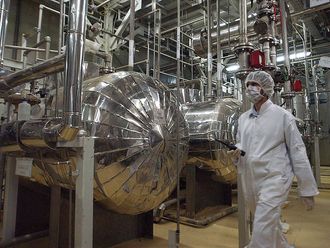DUBAI: At least 12 people have been killed in the ongoing protests in Iran, and armed protesters have tried to take over police stations and military bases, state TV reported on Monday.
The protests began on Thursday in Mashhad over economic issues and have since expanded to several cities. Hundreds of people have been arrested.
The state TV report said 10 were killed during clashes on Sunday night, without elaborating. Two demonstrators were killed during a protest in western Iran late Saturday.
President Hassan Rouhani acknowledged the public’s anger over the country’s flagging economy, though he and others warned the government wouldn’t hesitate to crack down on those it considers lawbreakers. Here’s what we know so far:
How did the protests start?
The demonstrations began on Thursday in Mashhad, Iran’s second-largest city and the home of a famous Shiite shrine. The city is a conservative bastion and a stronghold of Ebrahim Raisi, a cleric who unsuccessfully challenged President Hassan Rouhani in last year’s election. Analysts suggest conservatives began the protests there as a means to pressure Rouhani, a relatively moderate cleric within Iran’s theocratic government. The protests then rapidly spread throughout the rest of the country of 80 million people.
What do protesters want?
Demonstrators initially focused on Iran’s flagging economy. Despite now being able to sell oil on the international market after the 2015 nuclear deal, Iran faces rising inflation and high unemployment. A recent increase in egg and poultry prices by as much as 40 per cent, which a government spokesman has blamed on a cull over avian flu fears, appears to have sparked the protests. Protesters have chanted against Rouhani as well as Supreme Leader Ayatollah Ali Khamenei. Some have criticised Iran’s military support of the Syrian regime of Bashar Al Assad, while others have praised the US-backed shah, who fled into exile just before the 1979 Islamic Revolution and died of cancer the following year.
Who is leading the protests?
So far, no central leadership has emerged. That’s in contrast to the 2009 Green Movement demonstrations, which protested hardline President Mahmoud Ahmadinejad’s re-election amid widespread allegations of voter fraud. Those protests, Iran’s biggest since 1979, prompted a crackdown by Iran’s paramilitary Revolutionary Guard and its affiliates that saw thousands detained, dozens killed and others tortured. Its leaders remain under house arrest years later. While leaderless, these new protests have been fanned in part by an exiled journalist named Roohallah Zam using a mobile phone messaging app called Telegram.
How has the government responded?
Iran says it temporarily shut down access to both Telegram and the photo-sharing app Instagram to “maintain peace,” limiting protesters’ ability to share images and publicise rallies. Facebook and Twitter are already banned. Uniformed and plainclothes police are in the streets, as are motorcycle-riding members of the Basij, a volunteer force under the Revolutionary Guard that helped carry out the 2009 crackdown. Rouhani himself has said Iran allows protests, and authorities often tolerate smaller, limited demonstrations and labour strikes. But Rouhani and other officials have warned that the government won’t hesitate to crack down on those it considers lawbreakers.
Is Iran a democracy?
Iran describes itself as an Islamic republic. Elected representatives pass laws and govern on behalf of their constituencies. However, the supreme leader has the final say on all state matters. The Guardian Council, a 12-member panel half selected by the supreme leader and half nominated by the judiciary and approved by parliament, must approve all laws. The council also approves all presidential and parliamentary candidates, barring anyone who challenges the political system itself or advocates dramatic reform. Security forces answering only to the supreme leader, like the Revolutionary Guard, routinely arrest dual nationals and foreigners, using them as pawns in international negotiations.
What will happen next?
Demonstrators have called for more protests in the days ahead. While Rouhani has said the government allows demonstrations, all so far have been held without police permission, which is illegal. Ultimately, the supreme leader will decide how to respond. As Cliff Kupchan at the Eurasia Group wrote in an analysis Sunday: “When it comes to regime survival, Khamenei calls the shots. And he’s got a lot of loyal and ruthless troops at his disposal.”












